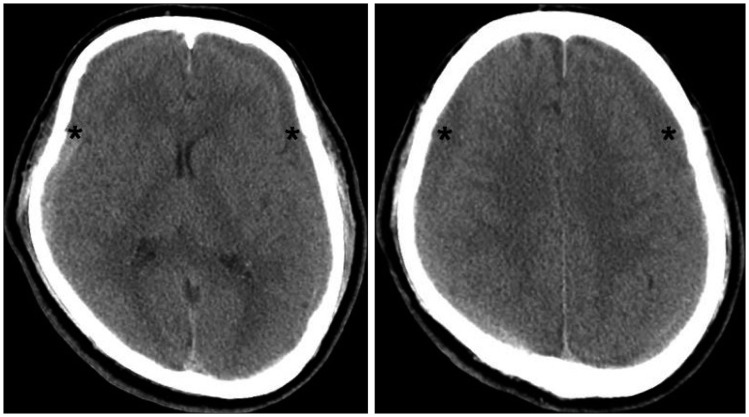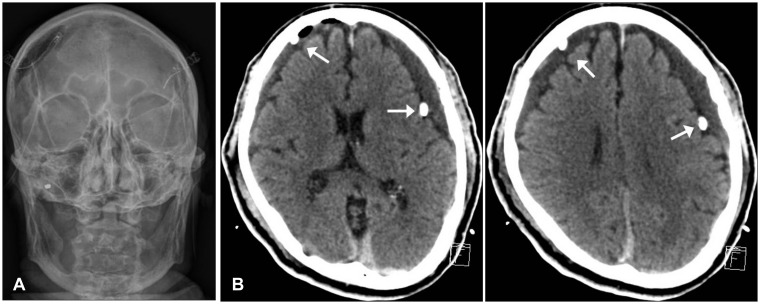This article has been
cited by other articles in ScienceCentral.
Abstract
Incidence of post-operative seizure after burr-hole trephination (BHT) for chronic subdural hematoma (CSDH) is known to be very low. The effect of the prophylactic antiepileptic drug in reducing the development of new seizure after surgery is still unclear. Here, we present a case of fatal status epilepticus with progressive respiratory complication following early discontinuation of prophylactic antiepileptic drug in an 84-year-old man who had undergone bilateral BHT and closed-system drainage for bilateral CSDH. Although the efficacy of the prophylactic anticonvulsants in BHT for CSDH has been controversial, the development of status epilepticus postoperatively seems to be strongly associated with an increased mortality rate in aged patients. Therefore, prophylactic anticonvulsants should be administrated in aged patients who undergo surgery for CSDH, until a definitive clinical treatment guideline is suggested.
Go to :

Keywords: Aged, Anticonvulsants, Hematoma, subdural, chronic, Status epilepticus
Introduction
Chronic subdural hematoma (CSDH) is one of the predominant neurological diseases in the elderly patients. CSDH is defined as a cystic collection of old hematoma and blood breakdown products between the outer and inner membranes in the subdural space; it usually develops 1 or 2 months after a minor head injury.
2) In general, a high treatment success rate and good prognosis for CSDH can be expected by a simple procedure of burr-hole trephination (BHT) and closed-system drainage under local anesthesia.
3)
The incidence of post-operative seizure in patients who underwent BHT for CSDH is known to be about 5%.
1) Therefore, the use of prophylactic antiepileptic drug after BHT for CSDH has been controversial. Here, we present a case of fatal status epilepticus with progressive respiratory complication following early discontinuation of prophylactic antiepileptic drug in an 84-year-old man who had undergone bilateral BHT and closed-system drainage for bilateral CSDH. We also review the available previous literature.
Go to :

Case Report
An 84-year-old man, experiencing dizziness and headache for 2 weeks, was admitted to our hospital. Approximately 1 month before admission, he had suffered a mild head injury resulting from a fall. Seven years before the present admission, he had undergone radical nephrectomy surgery for renal cell carcinoma. He had also been taking medications for hypertension and asthma for the past several years. Neurological examination revealed no abnormalities. Cranial computed tomography (CT) scans revealed CSDH with mixed densities on the bilateral cerebral convexities with mass effects (
Figure 1). Prophylactic antiepileptic drug with intravenous valproic acid 1,200 mg was administered pre-operatively on the operation day. He underwent BHTs in the bilateral posterior parietal bone with closed-system drainage under local anesthesia. Postoperative skull X-ray revealed two fixed catheters through bilateral parietal burr-holes (
Figure 2A). Cranial CT scans obtained 3 days after BHT revealed a significant decrease in the bilateral CSDH without mass effects (
Figure 2B). The postoperative course was uneventful, and the patient was discharged after 7 days with no neurological deficits. He had been taking 900 mg of valproic acid daily until 12 days postoperatively, and then stopped the medications owing to increased levels of the enzymes, aspartate transaminase and alanine transaminase, in the liver blood test. On postoperative day 16 (5 days after the discontinuation of the antiepileptic drug), the patient was admitted to the emergency room with status epilepticus after a generalized tonic-clonic convulsion for 80 minutes. Although his convulsion stopped after the management of status epilepticus in accordance with the guidelines, his consciousness did not recover, and deteriorated to a Glasgow Coma Scale 4 score of (E1, V1, M2). The patient's condition continued to deteriorate until he died of pneumonia 1 month after the burr-hole craniotomy.
 | FIGURE 1Computed tomography scans reveal chronic subdural hematomas (asterisks) with mixed densities on bilateral cerebral convexities with mass effects.
|
 | FIGURE 2A: Postoperative skull X-ray reveals fixed two fixed catheters through bilateral parietal burr-holes. B: Computed tomography scans obtained 3 days after the burr-hole trephination reveal significant decrease in bilateral chronic subdural hematomas without mass effects. The catheter is noted (white arrows) within subdural space.
|
Go to :

Discussion
CSDH is a frequently encountered problem in neurosurgical practice. The risk factors include brain atrophy, coagulopathy, alcohol abuse, seizure disorders, shunts that drain excess cerebrospinal fluid from the brain, and head trauma.
3) In the past, non-specific symptoms and signs of CSDH were mistaken for cerebrovascular disease, brain tumor, and Alzheimer's disease, but recently, the frequency and identification of CSDH has increased owing to the development of diagnostic techniques such as CT or magnetic resonance imaging, and extension of the average life span.
1) The surgical treatments for CSDH include several methods, such as, twist-drill drainage, BHT and closed-system drainage, craniotomy and capsulectomy, and subduro-peritoneal shunt.
3) Although there have been some debates about the effects and safety of the various surgical methods, BHT with closed-system drainage has been considered as a simple and effective method for the treatment of CSDH.
1)
Incidence of post-operative seizure after BHT for CSDH is known to be very low. The effect of the prophylactic antiepileptic drug in reducing the development of new seizure after surgery is still unclear.
156) Sabo et al.
6) reported that when using prophylactic anticonvulsants, seizure activity occurred in 2.4% of patients after surgery, while it occurred in 32% of patients when not using antiepileptic drug, and hence, they recommended the use of an antiepileptic drug with phenytoin. However, Rubin and Rappaport
5) reported that when using prophylactic antiepileptic drug, seizure occurred in 4.8% of patients, while it occurred in 3.4% when not using antiepileptic drug, and hence, they did not recommend the use of a prophylactic antiepileptic drug. Prophylactic administration of anticonvulsants is generally recommended when the occurrence risk of epilepsy exceeds 10% to 15%.
1) Thus, some authors recommended the use of a prophylactic antiepileptic drug, only in the case of CSDH that shows mixed density lesions on pre-operative CT. For example, in a study by Chen et al.
1) the incidence of early post-operative seizures was 13.7% in the mixed-density CSDH group on pre-operative CT. Grobelny et al.
4) suggested that the prophylactic anticonvulsants before surgery are likely associated with the reduction of post-operative seizure in patients with CSDH treated with BHT. However, they noted no effect on discharge outcome, as determined by the modified Rankin Scale score, between the preoperative and postoperative initiation of the prophylactic antiepileptic drug. Additionally, in their study, the presence of neither preoperative nor postoperative seizures was found to have a significant effect on the outcome at discharge.
4)
Sabo et al.
6) demonstrated a significant increase in morbidity and mortality associated with respiratory complications and status epilepticus after surgery of CSDH, including investigations of previous literature. Because the elderly patients group is more vulnerable to and fatally affected by this complication, they emphasized that the older patients may have the most to gain by seizure avoidance. They also recommended the use of prophylactic anticonvulsants with phenytoin in patients treated surgically for CSDH.
In our case, the patient was 84 years old and underwent bilateral BHT for bilateral CSDH. After early discontinuation of the antiepileptic drug, he died with fatal status epilepticus and respiratory complications. Although the efficacy of the prophylactic anticonvulsants in BHT for CSDH has been controversial, the development of status epilepticus postoperatively seems to be strongly associated with an increased mortality rate in elderly patients. Therefore, prophylactic anticonvulsants should be administrated in elderly patients who undergo surgery for CSDH, until a definitive clinical treatment guideline is suggested. A larger prospective research is warranted in the future to further clarify the efficacy of this antiepileptic prophylaxis and avoid the fatal complication.
Go to :

Conclusion
Postoperative status epilepticus seems to be strongly associated with an increased mortality rate in aged patients. Therefore, prophylactic coverage of anticonvulsants should be carefully considered in aged patients who undergo surgery for CSDH, until a definitive clinical treatment guideline is suggested.
Go to :







 PDF
PDF ePub
ePub Citation
Citation Print
Print


 XML Download
XML Download